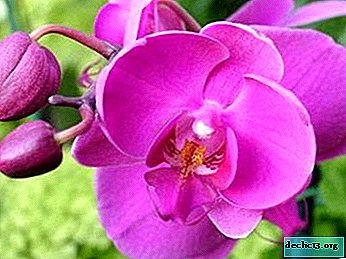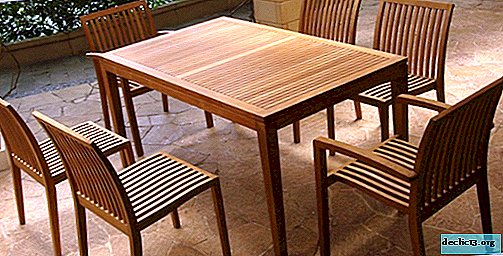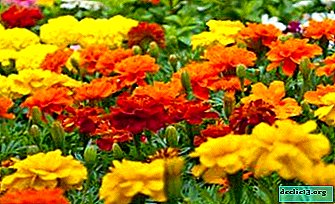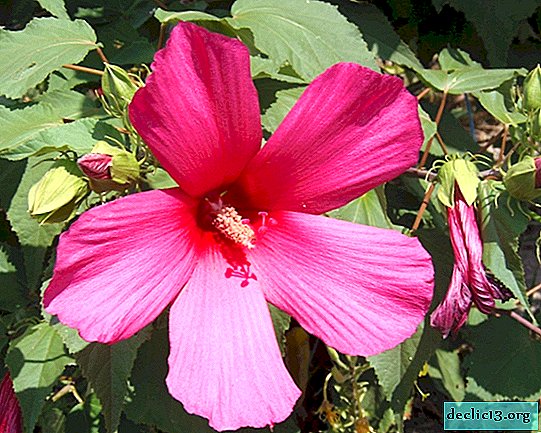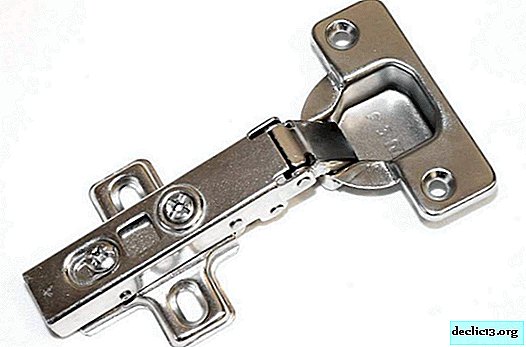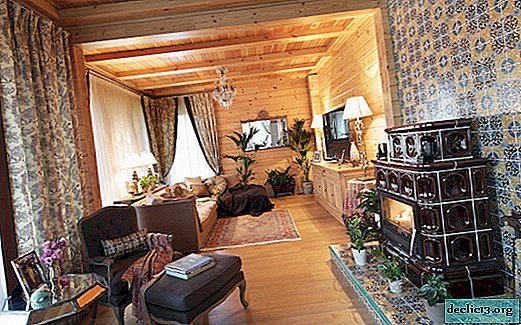Miniature azalea, Japanese geisha - description of Purple and Orange varieties, cultivation features
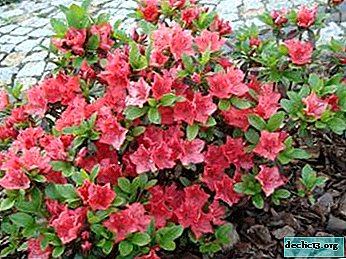
Azalea Japanese geisha is an amazing decorative culture, which is considered quite capricious in terms of care. It is distinguished by lanceolate leaves that resemble an egg in shape. The color palette is quite extensive, the flowers can be terry or simple type.
During the flowering of this culture, the room is filled with a pleasant aroma.
In the article we’ll tell you what kind of plant this is - Japanese geisha rhododendron, let's talk about its varieties Purple (or, as they say, People) and Orange.
Description
Japanese Azalea Geisha is a representative of the smallest miniature rhododendrons. It belongs to the garden group of Japanese azaleas.
Reference! The peculiarity of Japanese azalea in the compactness of the bush and high density. The height of the plant is from 30 to 50 cm. The shape of the bush is pressed, resembling pillow-like and creeping rocks. The leaves are small, the length does not exceed 2 cm. They have a beautiful shape, leathery surface.This variety of rhododendrons is perfect for growing in central Russia, as it completely goes under the snow and does not suffer from freezing. At the end of May, the bush is completely covered with flowers, so that even the foliage is not noticeable. Flowering lasts 2-3 weeks.
History of occurrence
This plant was first brought to Europe in the 19-20 centuries. Only at that time his name was "Kurum azalea". It was then that the flower won great interest among gardeners and breeders. But due to insufficient winter hardiness, the culture was not widespread.
What is the difference from other rhododendron species?
Most the main difference from other types of rhododendrons in azalea is the Japanese geisha in plentiful and dense flowering. During this period, the bush is literally covered with bright and lush inflorescences, due to which the leaves are almost invisible. In addition, the culture is quite finicky, so a beginner will not be able to grow it.
Subcort
Geisha orange

A feature of the variety is the presence of bright and lush orange flowers. Because of its rich color, the bush will always stand out among all other plants. This variety of azalea responds to drought, so the soil around the plant should always be moist.
GEISHA PURPLE

This is a low and slowly growing bush, which after 10 years reaches a height of 0.4 m. The flowers are saturated purple color. Flowering occurs in the second half of May. When caring for a plant, regular watering is necessary. His leaves are glossy and semi-green. Grow the variety in shaded areas protected from the wind.
Bloom
When and how?
Azalea flowers of bright Japanese color: orange, purple. Their size is 3-4 cm, all of them are collected in inflorescences of 15-20 pieces. Flowering begins in mid-May, and ends in 1.5-2 months.
Care Features
Before and after flowering, the following care is important for her:
- Temperature indicators are 7-10 degrees, and during flowering - 10-15 degrees.
- For azalea, direct sunlight is unacceptable. So grow it in a spot with diffused lighting.
- During flowering, branches with azalea can be rearranged and rotated.
- To prolong flowering, remove all wilted flowers, and spray the plant itself, without getting water on the petals.
- After flowering, prune.
What to do if it does not bloom?
 The lack of flowering in azalea, Japanese geisha can be for several reasons:
The lack of flowering in azalea, Japanese geisha can be for several reasons:
- insufficient lighting;
- low temperature;
- defective watering;
- excessive introduction of nitrogen-containing fertilizing.
You can restore the decorative bush if you create all the conditions for it. For planting, choose a well-lit place, protected from draft. Add top dressing no more than 1 time in 2-3 weeks. At the stage of bud formation, exclude fertilizers with a high nitrogen content.
Use in landscape design
Attention! Azalea is great for single and group plantings in open ground. If you choose the second option, then when decorating the site, plant a plant at a distance of 2x2 m.The following plants can make her company:
- function
- ferns;
- Rogersia.
In the case when they bloom simultaneously with azalea, choose white flowers.
Plant care
Choosing a place for the plant
When choosing a site for planting azaleas, consider that she does not like stagnant and excess moisture. The place should be well lit, but only direct sunlight is not acceptable. You can grow bushes under the shade of con trees.
What should be the soil?
To plant azaleas, a special substrate with high acidity, moisture and air permeability with a high content of organic matter is required.
- If the site is sandy, then add peat, leafy humus and rotted compost to it.
- If the earth is clay, then loosen it with sand and peat. Act similarly in the presence of heavy soil.
Landing
 Landing activities to perform in spring or summer. Procedure:
Landing activities to perform in spring or summer. Procedure:
- Prepare pits for landing. The size must be large so that the seedling fits with an earthen lump. Depth 50 cm and width 70 cm.
- Lay a drainage layer at the bottom of the recess, the thickness of which is 15-20 cm. For this, small pebbles, gravel are suitable.
- Carefully water and remove seedlings from the container without injuring the root system.
- Add peat and fertile soil to the drainage layer.
- Place the seedlings in the planting recesses and sprinkle with the soil mixture, slightly compacting.
- Sprinkle the earth near the plant with mulch to prevent evaporation of moisture. Use sawdust, conifer needles and tree bark.
Temperature
In summer, temperature indicators should be 22-25 degrees, and in winter - 14-16 degrees. Subject to temperature conditions, the buds will ripen, and, therefore, the plant bloom profusely.
Watering
Azaleas suffer from the drying up of an earthen coma, but waterlogging adversely affects the state of the roots. It should be watered alternately - into the pot and into the pan, using only the settled soft water.
Top dressing
To make special fertilizers designed for azaleas in autumn. Carry out such events every 10 days. In addition, watering is required to acidify the soil (5 g of citric acid per 1 liter of water). Once every 14 days, water the culture with a mixture of acid peat and water.
Pruning
It should be carried out at the end of flowering. Using a sharp pruner, remove all damaged and wilted shoots. Cut the remaining branches partially throughout the bush to form the correct shape. The places of cuts should be treated with var.
Transfer
 If you grow a plant at home, then every 2-3 years a transplant is required. Procedure:
If you grow a plant at home, then every 2-3 years a transplant is required. Procedure:
- Prepare a nutrient mixture for the flower. This will require the following components:
- charcoal;
- river sand;
- pine bark;
- perlite.
- Dissolve Kornevin in water and immerse the flower in an earthen lump solution for 30 minutes.
- Remove azalea, wait for excess water to drain.
- Position the plant in the center of the new pot and sprinkle the roots evenly with soil, adding it to the sides of the coma and tamping a little.
Breeding
Seeds
Seed propagation procedure:
- Before planting, planting material should be treated with a disinfectant solution.
- In late February or early March, plant the seeds in a spacious container. Pour the soil composition into it, consisting of:
- peat;
- sand;
- sheet land;
- compost.
- Before sowing, loosen and water the soil.
- Lay the seeds on the ground, sprinkling with a small layer of sand.
- Cover the top of the container with glass, which is opened every day for ventilation.
- A pick is carried out after the appearance of 2-3 leaves.
Dividing the bush
Perform the division in the spring before sap flow and kidney formation. Procedure:
- Separate gently with a sharp shovel part of the plant.
- Use planting material with a large number of shoots and a well-developed root system.
- After separation, treat the cut site with wood ash.
- Plant a plant in a permanent place.
Cuttings
 Root cuttings in March-April. Procedure:
Root cuttings in March-April. Procedure:
- Apical shoots are suitable as planting material. Cut them into cuttings, the length of which is 10 cm.
- Remove the kidney and leaves.
- At the bottom of the cut, make a cut at 45 degrees and install it in the root formation solution for 2-3 hours.
- Prepared petioles should be placed in small pots with drainage holes and filled with peat.
- Cover planting with a film, maintain a temperature of 18-22 degrees. After 1.5 months, the cuttings will take root, they can be transplanted into the open ground.
Diseases and Pests
Important! The most common disease is fusarium wilting, in which the leaves fade and dry.The main cause is damage to the plant during transplantation or increased air temperature. For treatment, use a solution of Fundazole, and after 10 days, water the flower with a weak solution of potassium permanganate.
If the room has dry air, a spider mite may develop. This parasite is small, it sucks the juice from the underside of the leaf plate. Insecticides are used to control:
- Actara.
- Fitoverm.
- Omight.
Prevention of various problems
When growing Japanese azalea, the following problems are possible:
- Yellowing, wrinkling. The main cause of these symptoms is a lack of water in the ground.
- Poor flowering, yellowing of leaves. These problems occur with improperly selected soil. Azalea needs acidic soil, so you need to transplant the flower into a suitable substrate.
Azalea Japanese geisha is an amazing decorative culture that always stands out from the rest of the plants. In terms of growing it is capricious and requires attention. But then, subject to all conditions, the plant will bloom for a long time and plentifully, giving others an incredible aroma.


